Why Do Leaves Change Colors?
go.ncsu.edu/readext?741040
en Español / em Português
El inglés es el idioma de control de esta página. En la medida en que haya algún conflicto entre la traducción al inglés y la traducción, el inglés prevalece.
Al hacer clic en el enlace de traducción se activa un servicio de traducción gratuito para convertir la página al español. Al igual que con cualquier traducción por Internet, la conversión no es sensible al contexto y puede que no traduzca el texto en su significado original. NC State Extension no garantiza la exactitud del texto traducido. Por favor, tenga en cuenta que algunas aplicaciones y/o servicios pueden no funcionar como se espera cuando se traducen.
Português
Inglês é o idioma de controle desta página. Na medida que haja algum conflito entre o texto original em Inglês e a tradução, o Inglês prevalece.
Ao clicar no link de tradução, um serviço gratuito de tradução será ativado para converter a página para o Português. Como em qualquer tradução pela internet, a conversão não é sensivel ao contexto e pode não ocorrer a tradução para o significado orginal. O serviço de Extensão da Carolina do Norte (NC State Extension) não garante a exatidão do texto traduzido. Por favor, observe que algumas funções ou serviços podem não funcionar como esperado após a tradução.
English
English is the controlling language of this page. To the extent there is any conflict between the English text and the translation, English controls.
Clicking on the translation link activates a free translation service to convert the page to Spanish. As with any Internet translation, the conversion is not context-sensitive and may not translate the text to its original meaning. NC State Extension does not guarantee the accuracy of the translated text. Please note that some applications and/or services may not function as expected when translated.
Collapse ▲What a welcome change the fall is after a very hot summer. Pretty soon the hillsides will be a panorama of color with each curve of the road bringing more colorful surprises. Even those of us who are accustomed to the changing leaves each fall cannot help but be impressed and have been known to pull off the road to take a peek at our fall foliage.
But, have you ever wondered why the leaves change? It’s beautiful and it’s a miracle but it’s also science.
Leaves are the food factories of plants. They take carbon dioxide from the air and water from the soil. A process called photosynthesis turns this carbon dioxide and water into glucose (sugar). The green color in leaves which is called chlorophyll helps this to happen.
The gradual shortening of days tells the trees that winter is coming. Trees need to rest for the winter, living off the sugar that was stored during the summer. When the leaves stop making food, photosynthesis stops, causing the green leaf color to fade. This makes it possible for you to see yellow and orange colors. These colors were in the leaf all along but were hidden by the green of the chlorophyll. In some trees like maples, the sugar is trapped in the leaves after photosynthesis is stopped. Cold weather turns this sugar to red and purple.
It is a combination of all these things that gives us our beautiful fall colors. We don’t need to think about this process to enjoy the color of fall, but sometimes it is nice to know.

Photo: Donna Teasley




